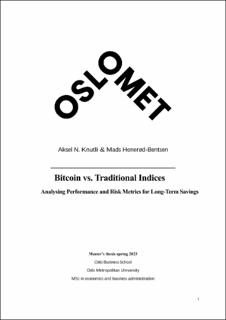| dc.description.abstract | This thesis compares investment strategies, volatility, correlation, downside risk measures and various risk performance ratios on Bitcoin, S&P 500 and NASDAQ Composite in various timeframes ranging between January 2013 and December 2022. The chosen timeframe is a relatively short period and gives our results some limitations. We considered Bitcoins total market cap to be too low before 2013, so it made sense to start where we did.
We examine various risk-adjusted performance ratios and risk measures of a lump sum investment in Bitcoin compared to S&P 500 and NASDAQ Composite over three periods: 2013-2022, 2018-2022 and 2020-2022. We find that Bitcoin has significantly outperformed both indices in terms of risk-adjusted returns over the 10- and 3-year holding periods but underperformed for the 5-year holding period. The high levels of potential return, however, comes at the cost of a considerably higher risk level, as shown by multiple risk measurements and other risk factors that are unique for cryptocurrencies, which ultimately emphasises the trade-off between risk and reward.
The results seem to fit nice with our correlation findings, where Bitcoin seems to have between none and very weak correlation with the indices based on daily returns for the last ten years.
We further investigated the effectiveness of a monthly dollar-cost averaging strategy for all assets over a 5-, 3- and 1-year timeframe. In this case, Bitcoin outperforms both indices over a 5-year interval but underperforms for the two shortest time horizons. Additionally, our study highlights the trade-off of both investment strategies by comparing them to one another. By only considering Bitcoin and when initiated in 2018, we find that dollar-cost averaging outperforms lump sum investment during bear markets. Conversely, when initiated in 2020, we show that lump sum investment outperforms dollar cost averaging during bull markets. | en_US |
